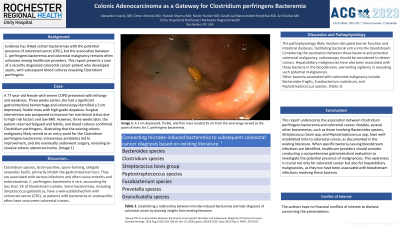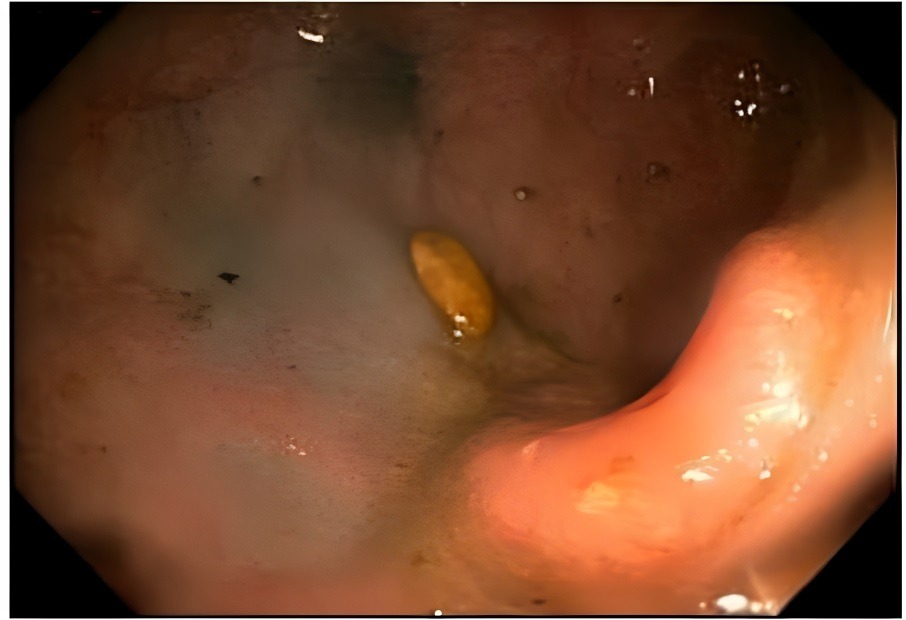Monday Poster Session
Category: Colorectal Cancer Prevention
P1790 - Colonic Adenocarcinoma as a Gateway for Clostridium perfringens Bacteremia
Monday, October 23, 2023
10:30 AM - 4:15 PM PT
Location: Exhibit Hall

Has Audio
.jpg)
Alexander Kusnik, MD
Unity Hospital
Rochester, NY
Presenting Author(s)
Alexander Kusnik, MD, Omer Ahmed, MD, Rutwik Sharma, MD, Nicole Hunter, MD, Sarath Lal Mannumbeth Renjithlal, MD, Ari Chodos, MD
Unity Hospital, Rochester, NY
Introduction: Evidence has linked certain bacteremias with the potential presence of colorectal cancer (CRC), but the association between C. perfringens bacteremia and colorectal malignancy remains often unknown among healthcare providers. This report presents a case of a recently diagnosed colorectal cancer patient who developed sepsis, with subsequent blood cultures revealing Clostridium perfringens.
Case Description/Methods: A 77-year-old female with severe COPD presented with lethargy and weakness. Three weeks earlier, she had a significant gastrointestinal hemorrhage and colonoscopy identified a 3 cm depressed, friable mass with high-grade dysplasia. Surgical intervention was postponed to improve her nutritional status due to high-risk factors and low BMI. However, three weeks later, the patient returned fatigued and febrile, and blood cultures confirmed Clostridium perfringens, illustrating that the existing colonic malignancy likely served as an entry point for the Clostridium perfringens bacteremia. Intravenous antibiotics led to improvement, and she eventually underwent surgery, revealing an invasive colonic adenocarcinoma.
Discussion: Clostridium species, Gram-positive, spore-forming, obligate anaerobic bacilli, primarily inhabit the gastrointestinal tract. They are associated with various infections and often cause enteritis and enterotoxemia. C. perfringens bacteremia is rare, accounting for less than 1% of bloodstream isolates. Some bacteremias, including Streptococcus gallolyticus, have a well-established link with colorectal cancer (CRC), as patients with bacteremia or endocarditis often have concurrent colorectal tumors. The pathophysiology likely involves disrupted barrier function and intestinal dysbiosis, facilitating bacterial entry into the bloodstream. Considering the association between these bacteria and potential colorectal malignancy, colonoscopy should be considered to detect tumors. Hepatobiliary malignancies have also been associated with these bacteria in the bloodstream, warranting vigilance in excluding such potential malignancies. Other bacteria associated with colorectal malignancy include Bacteroides fragilis, Gemella morbillorum, Fusobacterium nucleatum, and Peptostreptococcus species. In conclusion, identifying specific bacteria causing bloodstream infections should prompt a comprehensive gastrointestinal evaluation to investigate the potential presence of malignancy.

Disclosures:
Alexander Kusnik, MD, Omer Ahmed, MD, Rutwik Sharma, MD, Nicole Hunter, MD, Sarath Lal Mannumbeth Renjithlal, MD, Ari Chodos, MD. P1790 - Colonic Adenocarcinoma as a Gateway for Clostridium perfringens Bacteremia, ACG 2023 Annual Scientific Meeting Abstracts. Vancouver, BC, Canada: American College of Gastroenterology.
Unity Hospital, Rochester, NY
Introduction: Evidence has linked certain bacteremias with the potential presence of colorectal cancer (CRC), but the association between C. perfringens bacteremia and colorectal malignancy remains often unknown among healthcare providers. This report presents a case of a recently diagnosed colorectal cancer patient who developed sepsis, with subsequent blood cultures revealing Clostridium perfringens.
Case Description/Methods: A 77-year-old female with severe COPD presented with lethargy and weakness. Three weeks earlier, she had a significant gastrointestinal hemorrhage and colonoscopy identified a 3 cm depressed, friable mass with high-grade dysplasia. Surgical intervention was postponed to improve her nutritional status due to high-risk factors and low BMI. However, three weeks later, the patient returned fatigued and febrile, and blood cultures confirmed Clostridium perfringens, illustrating that the existing colonic malignancy likely served as an entry point for the Clostridium perfringens bacteremia. Intravenous antibiotics led to improvement, and she eventually underwent surgery, revealing an invasive colonic adenocarcinoma.
Discussion: Clostridium species, Gram-positive, spore-forming, obligate anaerobic bacilli, primarily inhabit the gastrointestinal tract. They are associated with various infections and often cause enteritis and enterotoxemia. C. perfringens bacteremia is rare, accounting for less than 1% of bloodstream isolates. Some bacteremias, including Streptococcus gallolyticus, have a well-established link with colorectal cancer (CRC), as patients with bacteremia or endocarditis often have concurrent colorectal tumors. The pathophysiology likely involves disrupted barrier function and intestinal dysbiosis, facilitating bacterial entry into the bloodstream. Considering the association between these bacteria and potential colorectal malignancy, colonoscopy should be considered to detect tumors. Hepatobiliary malignancies have also been associated with these bacteria in the bloodstream, warranting vigilance in excluding such potential malignancies. Other bacteria associated with colorectal malignancy include Bacteroides fragilis, Gemella morbillorum, Fusobacterium nucleatum, and Peptostreptococcus species. In conclusion, identifying specific bacteria causing bloodstream infections should prompt a comprehensive gastrointestinal evaluation to investigate the potential presence of malignancy.

Figure: A 3 cm depressed, friable, and firm mass located 35 cm from the anal verge served as the point of entry for C. perfringens bacteremia.
Disclosures:
Alexander Kusnik indicated no relevant financial relationships.
Omer Ahmed indicated no relevant financial relationships.
Rutwik Sharma indicated no relevant financial relationships.
Nicole Hunter indicated no relevant financial relationships.
Sarath Lal Mannumbeth Renjithlal indicated no relevant financial relationships.
Ari Chodos indicated no relevant financial relationships.
Alexander Kusnik, MD, Omer Ahmed, MD, Rutwik Sharma, MD, Nicole Hunter, MD, Sarath Lal Mannumbeth Renjithlal, MD, Ari Chodos, MD. P1790 - Colonic Adenocarcinoma as a Gateway for Clostridium perfringens Bacteremia, ACG 2023 Annual Scientific Meeting Abstracts. Vancouver, BC, Canada: American College of Gastroenterology.
